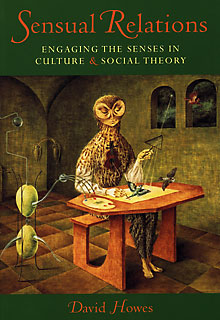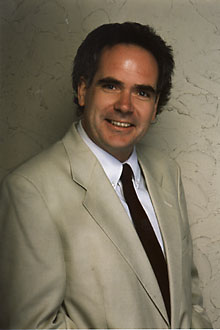David Howes’ new book focuses on the senses

The book cover for David Howes’s Sensual Relations. In the painting, an androgynous, owl-like figure sits at a drawing table. In one hand, the figure holds a prism that focuses a moonbeam onto the page; in the other hand is a brush attached to a violin which she/he uses to draw a series of birds that take flight. Varo’s painting “marvelously conveys the theme of the crossing of the senses which recurs throughout this book,” Howes says.
David Howes has a nose for alternative ways of looking at things.
Whether it’s the scented lavender fields of southern France or the texture of a woven basket in a museum, he is interested in the way the significance of objects can be conveyed through “multiple sensory channels.”
Howes, a professor in Concordia’s Department of Sociology and Anthropology, is involved in several research projects looking at the relative importance of the five senses in different cultures.
In the Western tradition, he argues, the “lower senses” of smell, taste and touch are generally overshadowed by sight and hearing, considered the most rational and civilized of the senses. There is also a tendency to separate the senses.
“This visualism and separatism as regards the senses can interfere with understanding objects and processes of communication in their multisensory splendour, both in non-Western cultures and the West itself,” he said in an interview.
“You might be missing important elements of the meaning of things or the meaning of communication in those societies because of your visual bias.” The senses have long been neglected as an area for legitimate academic research in anthropology.
Howes travelled to Papua New Guinea to study the customs of two oral societies. He found that although they lack a written tradition, they were not necessarily aural societies, contrary to what some theorists would suppose. “What I found is that people in an oral society can nevertheless be very eye-minded or very nose-minded.”
The results of that research are one of the components in his new book, Sensual Relations: Engaging the Senses in Culture and Social Theory, published by the University of Michigan Press.
In the book, Howes has mapped some of the varieties of sensory experiences in different societies. He argues that “different cultures represent different combinations of the senses.” This notion is expressed by the painting The Creation of the Birds, by Remedios Varo which adorns the cover.

David Howes
In addition, Howes serves as the principal investigator on an interdisciplinary study of the “sensory biases” of collected objects in modern Western culture, titled The Sense Lives of Things.
Bringing together researchers from several departments at Concordia and several institutions in Montreal, the project examines the sensorial and cultural dimensions of collecting and display in places like homes, churches, museums and stores.
As an example, Howes cited ethnographic museums, where objects representing other cultures are typically encased in glass. The resulting focus on the visual aspects of things to the exclusion of other senses compromises the meaning a viewer derives from the display, he argued.
“You shouldn’t just look at a basket, you’ve got to feel the different textures of it, smell what it’s made of to understand its full significance of its culture of origin.”
Indeed, travellers should dare to follow their noses more when exploring other cultures and places, Howes said. Some years ago, he collaborated in devising a “scented tour” of the Provence region in Southern France that involved “sampling the scents” of lavender fields, perfume factories, truffle emporiums and religious establishments in the area.
“We arrived at a very different appreciation of the place,” he said. “The whole experience of touring can be enriched by abandoning the model of sightseeing and actually exploring how to access a place through other senses.”